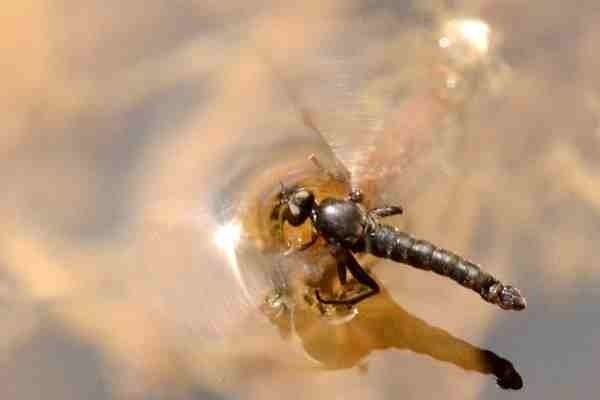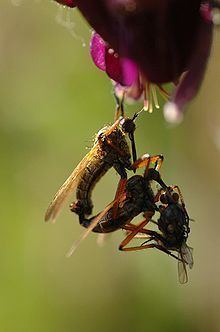Scientific name Empididae Rank Family | ||
 | ||
Lower classifications Empis, Rhamphomyia, Hilara, Empis tessellata | ||
Dagger flies empididae mating with nuptial gift presented to female
Empididae is a family of flies with over 3,000 described species occurring worldwide in all the Ecozones but the majority are found in the Holarctic. They are mainly predatory flies like most of their relatives in the Empidoidea, and exhibit a wide range of forms but are generally small to medium sized, non-metallic and rather bristly.
Contents
- Dagger flies empididae mating with nuptial gift presented to female
- Mating empididae
- Description
- Biology
- Evolution and systematics
- Species Lists
- Identification
- References

Common names for members of this family are dagger flies (referring to the sharp piercing mouthparts of some species) and balloon flies. The term "dance flies" is sometimes used for this family too, but the dance flies proper, formerly included herein, are now considered a separate family Hybotidae.
Mating empididae
Description
For terms see Morphology of Diptera.

Empididae are small to medium-sized flies, rarely large (1.0 to 15.0mm.).The body is slender,or elongated and rarely thickset. The colour ranges from yellow to black, and they may be pollinose or lustrous, but never have a metallic gloss. The head is often small and rounded with relatively large eyes.The eyes of the male and (rarely) the female may be contiguous (holoptic). The antenna usually have three segments of which the third is the largest and bears a long or short, usually apical arista or style.The eyes often have an incision (notch) at the level of the antennae.The proboscis is often long and in several genera powerful and piercing. If the mouthparts are strongly elongate they project forward or downward toward the fore legs. Some species have short mouthparts. The legs are usually long and slender but often powerful and in some cases the fore legs are raptorial, adapted to catching and holding prey.The wings are clear or partially tinged and, in some species, with a stigma spot,or with a distinct pattern. Radial vein R4+5 is often forked and the discal-medial cell (dm) is almost always present. The venation of the wings in minute species is often simplified. The posteror part of the wings on the basal side of the anal vein bears the designation of axillary or anal lobe. In species with a highly developed axillary lobe, the margin may form an angle with the margin of the alula.This is termed the axillary angle, the size of which is often a good diagnostic feature.

The larvae have an incomplete head capsule incomplete (hemicephalic) which is often retracted into the thorax 8-segmented abdomen with paired parapods on abdominal segments 1 - 7 or 1 - 8. The posterior spiracles are quite widely separated and the anal segment is frequently lobed. The pupae is without a puparium.
Biology

Adult empidids are found in a variety of forest habitats, on the leaves of plants, on tree trunks, aquatic vegetation and also in stream beds and seepage habitats.Some species are associated with open areas such as grasslands, agricultural fields, marshes, coastal zones and beaches. Adults capture arthropod prey, including other Diptera (including other empidids, Hemiptera, Homoptera, Lepidoptera, Trichoptera,Thysanoptera, Hymenoptera, Neuroptera, Plecoptera, Ephemeroptera, Coleoptera, Collembola, and Acari. Because of their predation they are important natural and biological control agents of various pest insect species and as a group with a vast species diversity they occupy a wide range of habitats.Some adult Empididae also visit flowers to obtain nectar.At least a few groups (Iteaphila, Anthepiscopus, Anthalia, Allanthalia and Euthyneura) obtain all their protein needs by feeding on pollen. Larvae are generally found in moist soil, rotten wood, dung, or in aquatic habitats and also appear to be predaceous on various arthropods, particularly other Diptera larvae.

Some Empididae, such as the European species Hilara maura, have an elaborate courtship ritual in which the male wraps a prey item in silk and presents it to the female to stimulate copulation. It was first noticed that these flies carried "nuptial gifts" of silk by Baron Karl von Osten-Sacken.Empididae show diverse mating systems, ranging from species in which males aggregate in mating swarms, and compete for choosing females to sex-role reversed species in which females do aggregate and compete for the attention of choosing males. In some species, competition for the food provided by males is so strong that females have developed elaborate ornaments, including feathery “pennate” scales on their legs, darkened wings, and inflatable abdominal sacs that enhance their attractiveness.
Evolution and systematics
Empididae are well represented in amber deposits and the family certainly seems to have been well established by the Cretaceous period at the latest.
Two groups formerly placed here as subfamilies are now generally regarded as separate families in the Empidoidea: Atelestidae and Hybotidae. The Brachystomatidae are also sometimes separated as a distinct family, but this seems to be in error. The Microphorinae were long placed in the Empididae as a subfamily, then briefly classified as a distinct family, and are now considered a subfamily of the long-legged flies (Dolichopodidae).
Among the subfamilies currently placed herein, not all are confirmed to be monophyletic groups. Some rearrangements, in particular regarding the delimitation of Empididae versus Dolichopodidae – which together represent the bulk and the most advanced lineages of the Empidoidea – are likely to take place in the future. The Brachystomatinae, Empidinae and Hemerodromiinae however seem to be natural groups of closest relatives in their entirety, and the Clinocerinae apparently are for the largest part.
